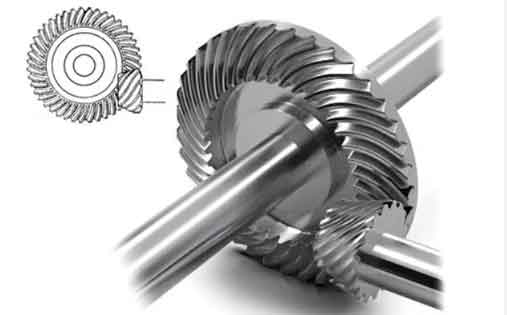This study proposes a novel approach for machining spiral bevel gears on universal 5-axis CNC machines using flat-bottom milling cutters, addressing the limitations of specialized equipment in cost and flexibility. The methodology combines gear meshing theory with envelope machining principles to achieve high-precision tooth surface generation.
1. Mathematical Modeling of Spiral Bevel Gear Tooth Surface
The tooth surface generation process is derived through coordinate transformations across multiple reference frames. The fundamental equation in the tool coordinate system $S_t$ is expressed as:
$$r_g = \begin{bmatrix}
(r_g – S_g \sin\alpha_g)\cos\theta_g \\
(r_g – S_g \sin\alpha_g)\sin\theta_g \\
-S_g\cos\alpha_g
\end{bmatrix}$$
where $r_g$ represents the cutter radius, $\alpha_g$ denotes the tool profile angle, and $S_g$, $\theta_g$ are machining parameters. The coordinate transformation matrix from tool to gear coordinate system is formulated as:
$$r_2 = M_{2g} \cdot M_{gd} \cdot M_{dm} \cdot M_{mc} \cdot M_{ct} \cdot r_g$$
Key transformation matrices include:
- Gear rotation: $M_{2g} = \begin{bmatrix}
\cos\phi_2 & -\sin\phi_2 & 0 & 0 \\
\sin\phi_2 & \cos\phi_2 & 0 & 0 \\
0 & 0 & 1 & 0 \\
0 & 0 & 0 & 1
\end{bmatrix}$ - Machine adjustment: $M_{gd} = \begin{bmatrix}
\cos\gamma_{m2} & 0 & \sin\gamma_{m2} & -X_2 \\
0 & 1 & 0 & 0 \\
-\sin\gamma_{m2} & 0 & \cos\gamma_{m2} & 0 \\
0 & 0 & 0 & 1
\end{bmatrix}$

2. Tool Path Planning Strategy
The machining process is divided into three stages with specific tool axis control strategies:
| Stage | Depth (mm) | Tool Orientation | Residual Error |
|---|---|---|---|
| Roughing | 2.5-3.0 | Normal to root cone | < 0.3 |
| Semi-finishing | 0.5-1.0 | Side milling | < 0.1 |
| Finishing | 0-0.2 | Adaptive side milling | < 0.02 |
2.1 Roughing Path Calculation
The maximum cutting depth is determined by root cone geometry:
$$s_{tm} = t_{pmin} \cdot [\tan(\alpha_{gw}) + \tan(\alpha_{gn})] + L_d$$
Tool axis vector maintains perpendicularity to root cone surface:
$$T_{rough} = \begin{bmatrix}
\frac{\partial F}{\partial x} \\
\frac{\partial F}{\partial y} \\
\frac{\partial F}{\partial z}
\end{bmatrix}$$
2.2 Precision Machining
Side milling tool orientation is controlled through dynamic adjustments:
$$T_{finish} = \sin\alpha \cdot f_n + \cos\gamma \cdot n \pm \sqrt{\sin^2\gamma – \sin^2\alpha} \cdot v$$
For concave surfaces, anti-interference modification is applied:
$$T’ = n \cdot \cos\gamma’_a + (f \times n) \cdot \sin\gamma’_a + f(f \cdot n)(1 – \cos\gamma’_a)$$
3. Simulation and Verification
The machining algorithm was validated using spiral bevel gears with parameters:
| Parameter | Pinion | Gear |
|---|---|---|
| Teeth | 15 | 28 |
| Module (mm) | 6 | |
| Pressure Angle | 20° | |
| Helix Direction | Right | Left |
Simulation results demonstrated:
- Surface roughness Ra ≤ 1.6μm
- Tooth profile error ≤ 0.03mm
- Processing time reduction: 35% vs conventional methods
4. Conclusion
This methodology enables efficient spiral bevel gear machining on universal 5-axis equipment using standard flat-bottom cutters. The three-stage tool path planning strategy achieves surface accuracy comparable to dedicated gear cutting machines while significantly improving processing flexibility. Future work will focus on adaptive machining parameter optimization for different spiral bevel gear specifications.
